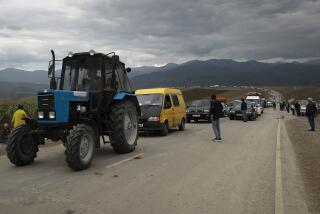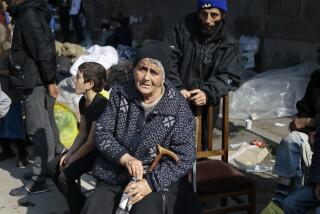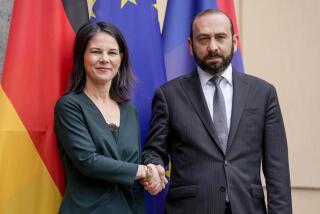Trying to Reconcile the Irreconcilable : Karabakh: A nasty ethnic war may be carried to a genocidal conclusion if alternatives aren’t found soon.
MOSCOW — Mountainous (Nagorno) Karabakh is remote even from the Armenian capital of Yerevan and the Azerbaijani capital, Baku. Yet the war between Armenians and Azerbaijanis, in its fourth year, threatens to draw in not only other peoples of the Commonwealth of Independent States but Turkey and Iran as well.
An already unstable region--the third republic in the area, Georgia, is torn by civil war--Transcaucasia has now gained the attention of world leaders fearful of a wider war on the northern tier of the Middle East. The region has already been devastated by brutal fighting between two peoples that history has placed side by side.
Karabakh, at the eastern end of the historic Armenian plateau, is a beautiful warren of valleys and mountains that in ancient times was the home of a people known as the Caucasian Albanians, who converted to the Armenian variant of Christianity and eventually merged completely with the Armenians.
For centuries, when Iran was the dominant power in eastern Transcaucasia, Armenian nobles ruled Karabakh and maintained a precarious autonomy. By the birth of the Soviet Union, Armenians made up more than three-quarters of the population of Karabakh, but instead of including them in neighboring Armenia, Stalin decided to form an autonomous region (Nagorno-Karabakh) within the Azerbaijani republic.
Never happy with Azerbaijani rule, Karabakh Armenians greeted perestroika with demonstrations demanding merger with the Soviet Republic of Armenia. But Mikhail Gorbachev, concerned about repercussions among non-Russians, especially Muslims, if the Kremlin began shifting borders, refused to accede to Armenian demands. Frustrated by their failure to gain their ends within the system, Armenians organized a massive national movement that eventually brought down the communist regime in their republic.
Azerbaijanis responded to the Karabakh movement with violent attacks on Armenians in February, 1988, in Sumgait and again in January, 1990, in Baku. Their Popular Front constantly pushed the communist leaders of the republic toward more militant resistance to the Armenians, but was unable to take power in its own right. On March 6 they forced the resignation of the recently elected president of the republic, Ayaz Mutalibov.
Two irreconcilable principles confront one another. The Armenians argue from the principle of national self-determination. Their majority in the region gives them a democratic claim to merger with Armenia, or at least self-rule. The Azerbaijanis, on the other hand, argue that borders are inviolable and that they are compelled to defend the territorial integrity of their homeland.
Step by painful step, the conflict has grown more brutal. More than 1,000 people have been killed, among them more than 30 “Soviet” soldiers and officers. Hundreds of thousands of Azerbaijanis were forced to flee Armenia, and equal numbers of Armenians were driven out of Azerbaijan. For years Azerbaijan has blockaded Armenia, cutting off fuel and building material needed to rebuild earthquake-damaged districts. Now both sides have acquired more destructive weapons from the disintegrating Soviet forces, including the vicious Grad missile system that fires 40 rockets one after the other in slightly different trajectories.
After the precipitous collapse of the Soviet Union, Karabakh became an international test of the coherence and influence of the new Commonwealth of Independent States. Russian President Boris Yeltsin and Kazakhstan President Nursultan Nazarbayev mediated a temporary cease fire-last September, but it failed. The Armenian Republic, perhaps the most vulnerable of all former Soviet republics economically and geopolitically, agreed to stand aside from the conflict and even to recognize the region as part of Azerbaijan. But Azerbaijan abolished the autonomous status of Mountainous Karabakh, and in December the Armenians there held a referendum and declared themselves an independent republic.
Karabakh is now a six-sided problem. Besides Armenia, Azerbaijan and Karabakh itself, it has become the immediate concern of Russia, Iran and Turkey. Yeltsin desperately wants to extricate his soldiers, but pulling out has proved difficult. Armenian women and children have lain down in front of the withdrawing tanks. Fights have broken out between Armenian fedayees (guerrillas) and Russian soldiers whom they tried to disarm.
Iran has also been attempting to mediate a solution. Reports from Tehran on Sunday said that representatives of Armenia and Azerbaijan had initialed a draft peace accord, to be ratified by the leaders of the two republics. But there was no mention in news reports from Iran of any representative of Karabakh’s Armenian majority taking part in the accord.
Iran worries that a prolonged war on its northern frontier could arouse the two-thirds of the world’s Azerbaijanis who live within its borders. Turkey is culturally and linguistically allied to Azerbaijan, and Turkish nationalists have been pressuring the government to aid their Turkic brethren.
What seems clear after four years is that neither the original hope of the Karabakh Armenians--that they be allowed to merge with Armenia--nor the Gorbachev plan--Armenian autonomy within Azerbaijan--is a viable solution. Two other outcomes seem feasible, if unlikely: partition of the region along ethnic lines, with the resulting adjustment of borders; or an independent Karabakh republic guaranteed by the international community.
If neither of these outcomes can be effected by outside intervention, then the little war will be carried to its most deadly conclusion. Eventually the Azerbaijanis, who outnumber the Armenians in Transcaucasia by 2 to 1, will retake Karabakh, and, after a long and bloody guerrilla resistance, the Armenians will experience at the end of the 20th Century a tragedy reminiscent of the one they suffered at its beginning.
More to Read
Sign up for Essential California
The most important California stories and recommendations in your inbox every morning.
You may occasionally receive promotional content from the Los Angeles Times.










